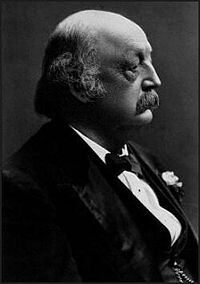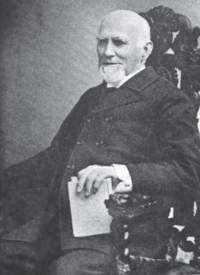- Civil Rights Act of 1871
-
Civil Rights Act of 1871 
Full title An Act to enforce the Provisions of the Fourteenth Amendment to the Constitution of the United States and for other Purposes Colloquial name(s) Ku Klux Klan Act Enacted by the 24th United States Congress Citations Stat. ch. 31, 17 Stat. 13 Codification Legislative history - Introduced in the House as H.R. 320 by Samuel Shellabarger (R-OH) on March 28, 1871
- Committee consideration by: House Select Committee on the President's Message, Senate Judiciary
- Passed the House on April 7, 1871 (118–91)
- Passed the Senate on April 14, 1871 (45–19)
- Reported by the joint conference committee on April 19, 1871; agreed to by the House on April 19, 1871 (93–74) and by the Senate on April 19, 1871 (36–13)
- Signed into law by President Ulysses S. Grant on April 20, 1871
Major amendments Relevant Supreme Court cases The Civil Rights Act of 1871, 17 Stat. 13, enacted April 20, 1871, is a federal law in force in the United States. The Act was originally enacted a few years after the American Civil War, along with the 1870 Force Act. One of the chief reasons for its passage was to protect southern blacks from the Ku Klux Klan by providing a civil remedy for abuses then being committed in the South. The statute has been subject to only minor changes since then, but has been the subject of voluminous interpretation by courts.
This legislation—also known as the Ku Klux Klan Act and formally titled An Act to enforce the Provisions of the Fourteenth Amendment to the Constitution of the United States, and for other Purposes—was asked for by President U.S. Grant, and passed within one month of the president's request for it to Congress. Grant's request was as a result of reports he was receiving of widespread racial terrorism in the Deep South, particularly in South Carolina. He felt that he needed to have his authority broadened before he could effectively intervene. After the act's passage, the president had the power for the first time to both suppress state disorders on his own initiative and to suspend the right of habeas corpus. Grant did not hesitate to use this authority on numerous occasions during his presidency, and as a result the first era KKK was completely dismantled and did not resurface in any meaningful way until the first part of the 20th century.[1] Several of its provisions still exist today as codified statutes, but the most important still-existing provision is 42 U.S.C. § 1983.
Contents
History
In January 1871, Republican Senator John Scott of Pennsylvania convened a congressional committee to hear testimony from witnesses of Klan atrocities. In February, Congressman Benjamin Franklin Butler of Massachusetts introduced his anti-Klan bill, intended to enforce both the Fourteenth Amendment and the Civil Rights Act of 1866. Butler's bill was narrowly defeated in the House, whereupon Rep. Samuel Shellabarger, of Ohio, introduced a substitute bill—only slightly less sweeping than Butler's original. This bill brought a few holdout Republicans into line, and the bill narrowly passed the House, sailed through the Senate and was signed into law on April 20 by President Ulysses S. Grant.[2]
Use during Reconstruction
Under the Klan Act during Reconstruction, federal troops were used rather than state militias to enforce the law, and Klansmen were prosecuted in federal court, where juries were often predominantly black. Hundreds of Klan members were fined or imprisoned, and habeas corpus was suspended in nine counties in South Carolina. These efforts were so successful that the Klan was destroyed in South Carolina and decimated throughout the rest of the former Confederacy, where it had already been in decline for several years. The Klan was not to exist again until its recreation in 1915, but it had already achieved many of its goals in the South, such as denying voting rights to Southern blacks.[2]
In its early history, under the Grant Administration, this act was used—along with the Force Act—to bring to justice those who were violating the Civil Rights of newly freed African Americans. After the end of the Grant Administration, and the dismantling of Reconstruction under Rutherford B. Hayes, enforcement of the Act fell into disuse and few cases were brought under the statute for almost a hundred years.
As Later Amended and Placed in U.S. Code as Section 1983
42 U.S.C. § 1983 now reads:[3]
- Every person who under color of any statute, ordinance, regulation, custom, or usage, of any State or Territory or the District of Columbia, subjects, or causes to be subjected, any citizen of the United States or other person within the jurisdiction thereof to the deprivation of any rights, privileges, or immunities secured by the Constitution and laws, shall be liable to the party injured in an action at law, Suit in equity, or other proper proceeding for redress, except that in any action brought against a judicial officer for an act or omission taken in such officer's judicial capacity, injunctive relief shall not be granted unless a declaratory decree was violated or declaratory relief was unavailable. For the purposes of this section, any Act of Congress applicable exclusively to the District of Columbia shall be considered to be a statute of the District of Columbia.
Section 1983 essentially made equitable relief available to those whose constitutional rights had been violated by an actor acting under State authority. Normally constitutional rights violations are remedied by specific performance including injunctions by the courts. For example, if a person's right to due process was violated by a prison guard who was said to be acting under the authority of the state, then that person could bring suit for monetary damages against the prison guard. Without Section 1983, that person would have to seek an injunction by the courts for the due process violation. The problem with such an action by the court is that injunctions cannot apply to past harm, only future harm. So, essentially the person would have an actionable cause-the constitutional violation-with no adequate remedy. Most Section 1983 claims are brought against prison officials by prisoners, but prisoner claims are usually dismissed as being without merit. Claims can be brought by anyone stating a proper cause of action.
Circumstances changed in 1961 when the Supreme Court of the United States articulated three purposes that underlay the statute: "1) 'to override certain kinds of state laws'; 2) to provide 'a remedy where state law was inadequate'; and 3) to provide 'a federal remedy where the state remedy, though adequate in theory, was not available in practice.' "[4][5]
Now the statute stands as one of the most powerful authorities with which state and federal courts may protect those whose rights are deprived. Section 1983 of the Civil Rights Act provides a way individuals can sue to redress violations of federally protected rights, like the First Amendment rights and the Due Process Clause and the Equal Protection Clause of the Fourteenth Amendment of the United States Constitution. Section 1983 can be used to enforce rights based on the federal Constitution and federal statutes, such as the prohibition of public sector employment discrimination based on race, color, national origin, sex and religion.
In some jurisdictions, 1983 has been applied directly to private employers when litigants have sued under this act. It can also be applied in virtually all jurisdictions in a more indirect manner to private employers if they are acting under state or federal authority. For example, if an additional private security company is hired by the police for an event and are given authority by the police, and, during the event, the security company violates a participant's First Amendment right, they can be sued under section 1983.
Although some provisions were ruled unconstitutional in 1882, the Force Act and the Klan Act have been invoked in later civil rights conflicts, including the 1964 murders of Chaney, Goodman, and Schwerner; the 1965 murder of Viola Liuzzo; and in Bray v. Alexandria Women's Health Clinic, 506 U.S. 263 (1993), in which the court ruled that "The first clause of 1985(3) does not provide a federal cause of action against persons obstructing access to abortion clinics."
It was also utilized in the 1969 case of Tinker v. Des Moines. By the time Beth Tinker was in school, the law had expanded to make even school boards liable if they stood in the way of people's federally-protected rights.
Today, the Civil Rights Act can be invoked whenever a state or local government official violates a federally guaranteed right. The most common use today is to redress violations of the Fourth Amendment's protection against unreasonable search and seizure. Such lawsuits concern false arrest and police brutality, most notably in the Rodney King case.
The Act was invoked in the 2010 Robbins v. Lower Merion School District case, where plaintiffs charged two suburban Philadelphia high schools secretly spied on students by surreptitiously and remotely activating webcams embedded in school-issued laptops the students were using at home, violating their right to privacy. The schools admitted to snapping over 66,000 webshots and screenshots secretly, including webcam shots of students in their bedrooms.[6][7]
Notes
- ^ Scaturro, Frank (1999). President Grant Reconsidered. Lanham, Maryland: Madison Books. pp. 71–72. ISBN 1-56833-132-0.
- ^ a b Trelease, Allen (1971). White Terror: The Ku Klux Klan Conspiracy and Southern Reconstruction. Baton Rouge: Louisiana State University Press. pp. 387ff. ISBN 0-8071-1953-9.
- ^ Ross, Darrell L. (2003). Civil Liability in Criminal Justice Third Edition. Anderson Publishing Co..
- ^ Monroe v. Pape, 365 U.S. 167 (1961).
- ^ Blum & Urbonya, Section 1983 Litigation, p. 2 (Federal Judicial Center, 1998) (quoting Monroe v. Pape). Pape opened the door for renewed interest in Section 1983 among American legal scholars.
- ^ Doug Stanglin (February 18, 2010). "School district accused of spying on kids via laptop webcams". USA Today. http://content.usatoday.com/communities/ondeadline/post/2010/02/school-district-accused-of-issuing-webcam-laptops-to-spy-on-students/1. Retrieved February 19, 2010.
- ^ "Initial LANrev System Findings", LMSD Redacted Forensic Analysis, L-3 Services – prepared for Ballard Spahr (LMSD's counsel), May 2010. Retrieved August 15, 2010.
External links
- Text of Civil Rights Act of 1871 as codified- 42 U.S. Code 21 §§1983, 1988
- 18 U.S.C. § 242 is "the criminal analog of 1983."
Categories:- Discrimination law in the United States
- History of African-American civil rights
- Reconstruction
- United States federal civil rights legislation
- United States federal criminal legislation
- Sovereign immunity in the United States
- 42nd United States Congress
Wikimedia Foundation. 2010.


